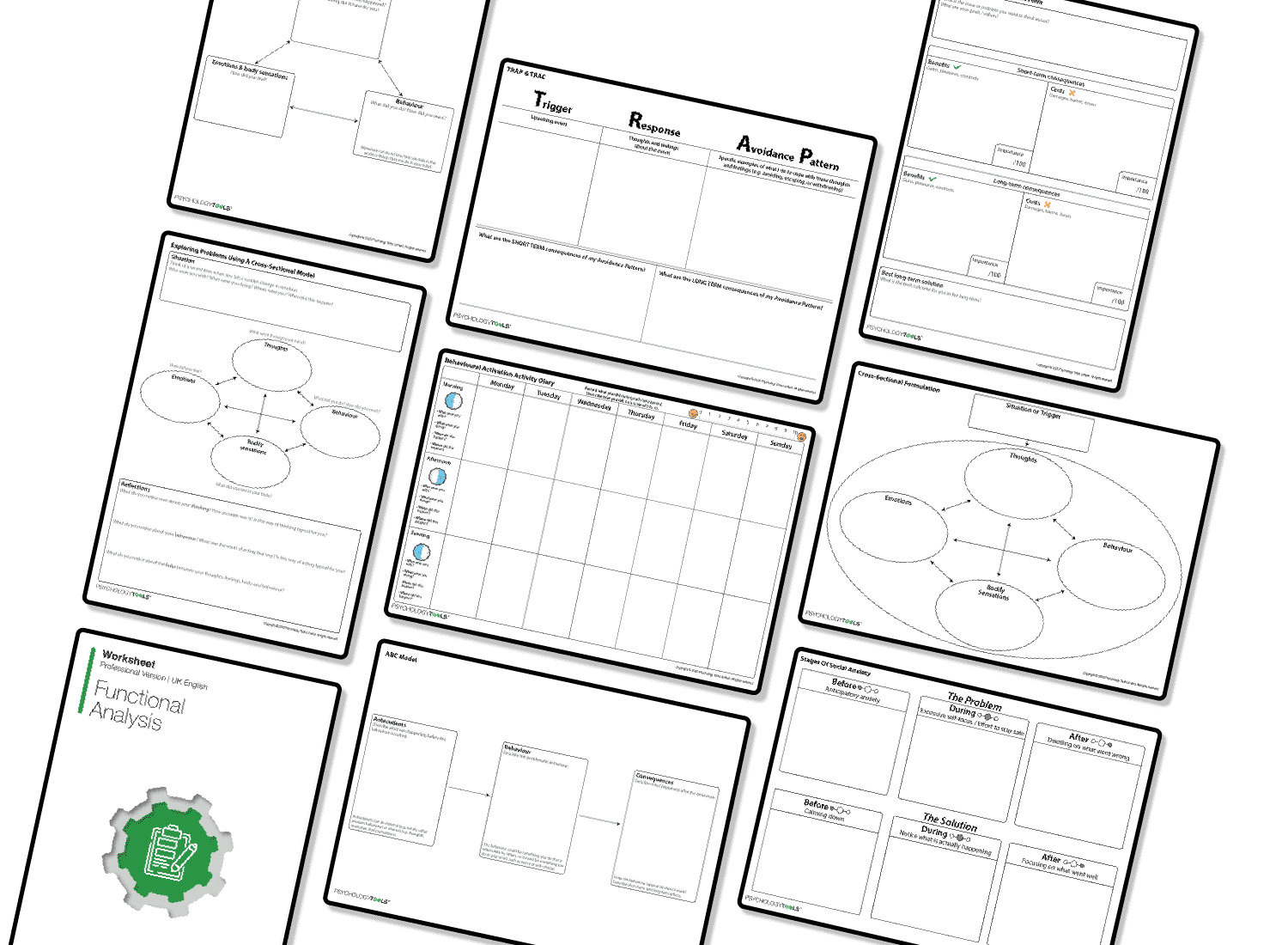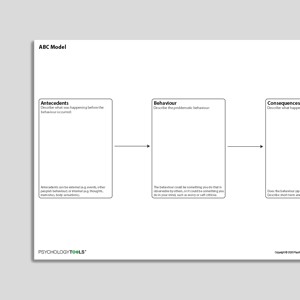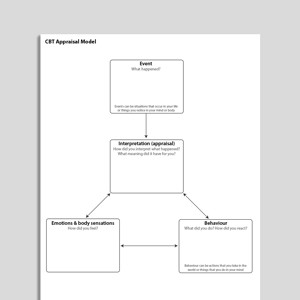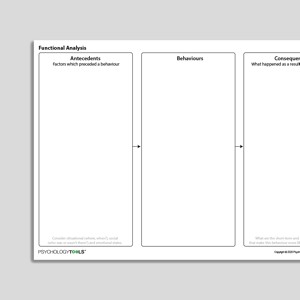Functional Analysis

ABC Model
Behavioral Activation Activity Diary
Behavioral Activation Activity Planning Diary
CBT Appraisal Model
Cross Sectional Formulation
Exploring Problems Using A Cross Sectional Model
Exploring Problems Using An A-B-C Model
Functional Analysis
Functional Analysis With Intervention Planning
Lapse And Relapse Management
Self-Monitoring Record (Universal)
Stages Of Social Anxiety
Links to external resources
Psychology Tools makes every effort to check external links and review their content. However, we are not responsible for the quality or content of external links and cannot guarantee that these links will work all of the time.
Information (Professional)
- Using functional assessment to understand challenging behavior and identify ways of supporting behavior change | Mark Addison | 2008
- What is a functional behavior assessment? The “WHY” of a behavior | Ohio Coalition for the Education of Children with Disabilities | 2002
- Functional analysis of behavior | Kelly Wilson, Amy Murrell | 2002
- Functional analysis of problem behavior: the basics | Brian Iwata | 2010
Protocols
- How To Conduct A Functional Assessment & Develop Behavior Plans To Reduce Problem Behaviors | Vincent Carbone, Gina Zecchin
Presentations
- Basic functional behaviour assessment (B-FBA) for high school students | Michelle Duda, Suzanne Kucharczyk | 2014
Treatment Guide
- Practical functional behavioral assessment training manual for school-based personnel | Sheldon Loman, Christopher Borgmeier | 2010
- Functional behavior assessments and behavior support plans
- Functional behaviour assessment
- Assessing behaviour that challenges shown by people with learning disabilities | National Institute for Health and Care Excellence | 2020
Recommended Reading
- Gresham, F. M., Watson, T. S., & Skinner, C. H. (2001). Functional behavioral assessment: Principles, procedures, and future directions.School Psychology Review,30(2), 156-172.
- Hanley, G. P., Iwata, B. A., & McCord, B. E. (2003). Functional analysis of problem behavior: A review. Journal of applied behavior analysis, 36(2), 147-185
- Haynes, S. N., O’Brien, W. H. (1999). Principles and practice of behavioral assessment. Springer.
- Iwata, B. A., Dorsey, M. F., Slifer, K. J., Bauman, K. E., & Richman, G. S. (1994). Toward a functional analysis of self‐injury. Journal of applied behavior analysis, 27(2), 197-209
What Is Functional Analysis?
Functional analysis takes its name from the goal of understanding the function that a particular behavior performs (Persons, 2008). The function of the behavior is defined as a response to particular contingencies in the environment or in the person. Contingencies are the causal relations between the behavior (the response) and things that happen before it (antecedents) or after it (the consequences).
Haynes & O’Brien (1990) define functional analysis as: “The identification of important, controllable, causal functional relationships applicable to a specified set of target behaviors for an individual client.” It is a method of behavioral analysis (Sulzer-Azaroff & Roy Mayer, 1977) which “is an intervention designed to modify behavior according to certain principles” (Sulzer-Azaroff & Roy Mayer, 1977). Assessments and treatments for problem behaviors are designed using the principles of behaviorism, applied behavioral analysis (ABA) and functional analysis (Carr & LeBlanc, 2003; Haynes & Hayes O’Brien, 2000; Rummel, Garrison-Diehn, Catlin, & Fisher, 2012). Functional analysis has its origins in work with children and young adults (Sulzer-Azaroff & Roy Mayer, 1977) and the treatment of problem behavior by people with developmental disabilities (Carr & LeBlanc, 2003). In 1977, Carr proposed that self-injury in this client group may be a learned behavior that is maintained through reinforcement – for example, receiving attention from other people following the behavior, or as a means to escape an activity or stimulus that they found aversive. Iwata and colleagues (e.g. 1994; Lerman & Iwata, 1993) used single-subject experiments to test whether self-injury could be modified by changing these hypothesized reinforcers. Thus, the function of the self-injury behavior was analyzed and, from this, the causes of the behavior were identified.
There are three stages to functional analysis (Carr & LeBlanc, 2003). First, a process of assessment records and monitors the target behavior and its antecedents and consequences in order to generate hypotheses about the contingencies that shape it. Contingencies are the things on which the behavior depends (Persons, 2008). For example, a behavior’s antecedents are the contexts, stimuli and events that are present before the behavior occurs and can be considered triggers. A behavior’s consequences are the things that occur as a result of the behavior and can be considered to be reinforcers that maintain it and make it more likely to happen in the future. Once hypotheses about the contingencies have been generated, the second stage of Functional Analysis is preparatory work for the final, third stage in which experiments are conducted to directly test those hypotheses with an individual client. When working within a cognitive-behavioral framework, you can consider the three stages of Functional Analysis as parallel to assessment, formulation, and intervention with evaluation.
For many, the third stage of experimental work forms the core of functional analysis since it is at this stage that hypothesized reinforcers of the behavior are modified, allowing identification of the things that cause and maintain the behavior (Haynes & Hayes O’Brien, 2000; Carr & LeBlanc, 2003). For example, following functional analysis, self-injurious behavior in individuals with developmental difficulties decreased when rest periods or rewarding activities were introduced during academic sessions (i.e. the hypothesis was that self-injury was a way to interrupt the academic sessions) or was extinguished by removing the sensory stimulation that the self-injury behavior provides (Iwata et al, 1994).
Relationships between behaviors and consequences
Behavioral approaches emphasize how an individual’s behavior is shaped by their environment – the individual learns associations between objects, events and experiences (stimuli) and their behavior. Classical conditioning and operant conditioning provide a vocabulary for understanding how the antecedents and consequences work to reinforce and maintain the behavior (Yoman, 2008; Haynes & Hayes O’Brien, 2000), in other words, what has made certain stimuli effective triggers (antecedents) and certain consequences effective reinforcers for maintaining the behavior (Haynes & Hayes O’Brien, 2000)?
Classical conditioning describes how something in the environment that does not naturally evoke any particular response (it is neutral, e.g. a pair of shoes) becomes associated with a naturally existing stimulus that does evoke a particular behavior because it is already trigger (e.g. a family member leaving the house).
Operant conditioning describes how voluntary behavior is shaped by consequences – what happens after the behavior. Operant behavior forms the backbone of work in functional analysis (Carr & LeBlanc, 2003; Iwata et al, 1994). Behavior followed by reinforcement will become more likely. Voluntary behavior that is followed by a punishment will become less likely. Punishment can be the application of something aversive or negative (e.g. being shouted at for throwing food) or the removal of something positive (e.g. being grounded for throwing food).
If a consequence leads to an increase in a behavior’s frequency then the behavior is said to be reinforced by the consequence. Similarly, punishment describes the decrease in the frequency of a behavior as a function of the behavior’s consequences. When a behavior no longer produces a consequence it goes through the process of extinction. Contingencies of reinforcement and punishment are given below:
| Following the behavior the stimulus is: | |||
| Presented | Removed | ||
| Effect on the probability of behavior | Increases | Positive reinforcement | Negative reinforcement |
| Decreases | Positive punishment | Negative punishment | |
Distinctive Features of Functional Behavior Analysis
Functional analysis is distinguished from other types of assessment and intervention by these features:
- Functional behavior analysis concerns itself with the behavior of individuals. This is termed an ‘idiographic’ approach. It is contrasted with a ‘nomothetic’ approach which would seek to generalize causes of behavior across individuals (e.g. according to diagnosis). Functional analysis moves the focus away from an individual’s diagnosis or history, and towards identifying changes that can address a problem behavior in the here-and-now. Due to this focus on observable behavior, functional analysis can be applied across many different diagnoses and settings (Haynes & Hayes O’Brien, 1990). It can be particularly useful where there is little evidence base for a treatment intervention, where a manualized treatment has not proven effective, when working with clients who have multiple diagnoses, or when working with clients who have limited verbal skills or who are not able to reflect on their own behavior (e.g. children, clients with learning disabilities, clients with acquired brain injuries, clients with dementia).
- Functional analysis concerns itself with the function of problem behavior.
A problem behavior is understood in terms of its goals and causal variables in order to answer the question ‘Why is this behavior occurring?’. Systematic monitoring and analysis of the behavior leads to a “a synthesis of a client’s behavior problems and the variables correlated with and hypothesized to affect those behavior problems” (p.9, Haynes & Hayes O’Brien, 1990). During an assessment the antecedents and consequences of the behavior are recorded. This allows the therapist to make hypotheses about what causes the behavior. For example, consider a client who routinely talks about off-topic subjects during their therapy sessions. On its own this information is not very informative, but this behavior may serve different functions. For example, it allows them to avoid speaking about difficult topics each time the therapist brings them up (avoiding an aversive stimulus) or the therapist does not probe with questions when they speak off-topic and continues to actively listen (social reward). - Functional analysis assumes that behavior cannot be understood in isolation. An individual learns associations between objects, events and experiences (stimuli) and their behavior. Thus, an individual’s behavior only makes sense when it is understood in the context of his or her environment. As described above, contingencies identified during functional analysis are used to explain what is causing the behavior (Carr & LeBlanc, 2003; Hayes & Hayes O’Brien, 1990). By applying knowledge from classical and operant conditioning, functional analysis uses the principles of behaviorism to give a mechanistic account of how the individual’s behavior is shaped by contingencies within the person and in their environment (Persons, 2008; Yomans, 2008). For example, imagine two clients attend a group treatment for post-traumatic stress disorder. Both are observed to sit silently through the sessions. At face value the behavior appears to be the same. However, when context is included in the analysis it becomes apparent that one client has occasions where she would like to speak but is experiencing frequent flashbacks (i.e. an aversive experience) which prevent her from speaking. The other client sits next to a vocally dominant member of the group and is interrupted every time they try to speak (i.e. there is a social punishment of interruption that prevents them from speaking).
- Functional analysis leads directly to treatment interventions. The hypotheses formulated during the first stages of functional analysis are tested by experimental interventions: “A well-done functional analysis leads logically to interventions that manipulate the environmental variables identified in the assessment” (Haynes & Hayes O’Brien, 1990). The interventions change or modify contingencies in order to treat the problem behavior (Carr & LeBlanc, 2003; Kuyken, Padesky & Dudley, 2009; Yoman, 2008). Antecedents are removed or replaced and consequences are changed, where possible (Yomans, 2008; Persons, 2008). The behavior itself can also be replaced by introducing a different, more adaptive behavior (Yomans, 2008; Persons, 2008). A critical part of the intervention is that it is experimental – that is, the problem behavior is monitored and data is collected to record its frequency, intensity and duration. It may be that some antecedents or consequences identified in the functional analysis are not actually causal in triggering or maintaining the behavior (Iwata et al, 1994; Persons, 2008). In which case, the hypothesis about that particular contingency is shown to be false, and an alternative contingency needs to be changed and experimentally tested (Lerman & Iwata, 1994).
Using Functional Behavior Analysis as Part of CBT Practice
At first glance, functional analysis may appear to have a scope of application limited to particular client groups. Some practitioners assume that it is best applied with clients who have developmental or cognitive difficulties or that it can only be applied to a voluntary motor behavior (hitting, self-injury and so on). However, the principles of functional analysis can be very successfully applied as a tool for assessment, formulation, and intervention within cognitive-behavioral framework with high-functioning clients (Persons, 2008; Yoman, 2008). Some example categories of behavior that can be fruitfully approached using functional analysis include:
- Observable behaviors. For example, eating, hitting, seeking reassurance, using substances, self-harm.
- Inhibiting or suppressing an urge, feeling or thought. For example, distracting oneself so as to avoid an urge to self-harm, suppressing an intrusive thought.
- Thoughts or cognitions that the client is able to report or record. For example, worry, rumination, self-criticism, self-distraction, compulsive counting or post-morteming: reviewing memories in an attempt to be certain.
- Feelings that can be reported and rated. For example, anxiety, sadness, anger.
- Physiological responses that can be reported and rated. For example, heart racing, nausea, temperature change, dry mouth.
- Communication behaviors within a relationship. For example, overly critical responses, not validating what the other person is saying, or responding negatively whenever certain topics are introduced.
Choosing a target behavior for functional analysis in CBT
For Functional Analysis to be helpful, a single target behavior should be identified. This is not always straightforward, and it is common for there to be multiple related problem behaviors (Haynes & Hayes O’Brien, 2000). It is important that the targeted behaviors are a high priority for the individual and not just symptoms defined by their diagnosis (Haynes & Hayes O’Brien, 2000; Persons, 2008; Yomans, 2008). An effective way to choose the behavior is to work through a process of prioritization that focuses on ‘ultimate outcomes’ (Yoman, 2008). This can be similar to approaches taken in Acceptance and Commitment Therapy such as working with values (Yomans, 2008). The therapist should ask “What are the long-term goals or consequences that the client (or their carers) seek?”
Practically, it is helpful to define a particular long-term outcome and to ask two questions: “Is this long-term outcome something that the client or their carers prioritize?” and “Is it something that the therapist can provide intervention for?”. For example, if problems are work related, a client may identify a long-term outcome of a pay rise which would reduce worry about money. If the lack of a pay rise is linked to procrastination and anxiety at work, this is something that can be targeted in therapy. If a lack of a pay rise is linked to cutbacks at the company, it cannot (Haynes & Hayes O’Brien, 2000; Yomans, 2008). When long term outcomes are established, discussions can begin to identify which behaviors will work positively towards those outcomes (Yoman, 2008) and which behaviors might be preventing them.
Using functional analysis to help clients understand problem behavior in CBT
Clients may find their behavior (or the problem behavior of their loved ones) distressing, scary and confusing. Elements of functional analysis can be used to help clients increase their understanding of a problem behavior and the causes behind it (Kuyken, Padesky, Dudley, 2009).
Assessment and formulation processes that identify the contingencies of the behavior can help clients to see why the behavior happens, what the triggers are and how its consequences can help to reinforce and maintain it (Kuyken, Padesky, Dudley, 2009; Yoman, 2008). It can also build the client’s awareness of the triggers of their behavior (the antecedents), and it’s short and long-term consequences. This can then lead naturally into interventions that change or modify the contingencies in order to address the problem behavior. For detailed guidance on these methods, see the ABC model.
Using functional analysis to address problem behaviors in CBT
Functional analysis examines the causes and consequences of behavior — it is a “powerful method of empirically identifying the variables that maintain a problem behavior” (Rummel, Garrison-Diehn, Catlin, & Fisher, 2012). The three stages of functional analysis can provide a systematic means to identify a problem behavior, understand the triggers (antecedents) and consequences that maintain it, and then to introduce interventions.
For example, a female client might present with problematic eating behaviors, and in particular describe raiding the fridge in middle of night and binge eating. The clinician and client could carefully explore what happened during the day before a night-time binge. The antecedents could be that the client would deliberately restrict their eating during the day and find the feeling of hunger rewarding because it was consistent with her goal of losing weight. However, this would cause her to wake in the night feeling extremely hungry, and binge on food (the problem behavior). In this case, the short-term consequence of binge eating was a feeling of pleasure that came with relieving her physiological state of starvation. A subsequent consequence of binge eating was feeling disgusted with herself. Following use of the Antecedent > Behavior > Consequence model the therapist could suggest that managing food intake during the day in a healthier manner might lead to a reduction in night-time binge eating. This more positive behavior (of calorific intake during the day) would also align with the client’s desires and values to be healthy. The client and therapist would therefore be able to develop a treatment plan based around this.
Applying functional behavior analysis to the therapist-client relationship in CBT
Functional analysis can also be used to manage and improve the therapist-client relationship. Persons (2008) describes several examples where elements of functional analysis were applied in this way. In one example, a client contacted the therapist regularly and at various hours of the night, and during those contacts threatened to commit suicide. Initially, the therapist attended to these contacts by providing support over the phone, entering into long conversations and trying to ‘talk down’ the client. The behavior developed into a problem, becoming unmanageable for the therapist. Applying some principles of functional analysis it was hypothesized that the therapist’s initial response to the behavior acted as a social reward (i.e. attention) and a reinforcing consequence that increased the frequency of the behavior. To address the behavior, the therapist altered the contingencies. Instead of entering into prolonged discussions the therapist provided the client with a suicide helpline number and stated that they would call the emergency services. Within a few weeks, the behavior had reduced in frequency and the therapist had a means to deal quickly with any future instances.
More subtle examples include applying functional analysis to therapist-client interaction. Persons considers how therapist responses moment to moment work to change the client’s disclosures during therapy (Persons, 2008). For example, a client may avoid discussing difficult topics in each session, preventing the therapist from making progress. On reflection, and considering the client’s behavior of avoidance, the therapist observes that they unintentionally reward the avoidance behavior by changing their question or changing the subject when they notice that the client is becoming distressed. This would encourage the therapist to try a different approach; encourage the client to consciously and deliberately approach difficult topics, and ‘sit with’ the feelings of distress.
References
- Carr, E. G. (1977). The origins of self-injurious behavior: A review of some hypotheses. Psychological Bulletin, 84, 800–816
- Carr, J.E. & LeBlanc, L.A. (2003) Functional Analysis of Problem Behavior, Ch. 28 in W. O’Donohue, J.E. Fisher, S.C.Hayes (Eds) Cognitive Behavior Therapy: Applying Empirically Supported Techniques in Your Practice. John Wiley & Sons, New Jersey
- Cooper, J. O., Heron, T. E., & Heward, W. L. (2007). Applied behavior analysis.
- Haynes, S. N., & O’Brien, W. H. (1990). Functional analysis in behavior therapy. Clinical Psychology Review, 10(6), 649–668.
- Haynes, S.N. & Hayes O’Brien, W. (2000) Principles and Practice of Behavioral Assessment. Kluwer Academic / Plenum Publishers: Applied Clinical Psychology Series, London.
- Iwata, B. A., Pace, G. M., Dorsey, M. F., Zarcone, J. R., Vollmer, T. R., Smith, R. G., et al. (1994). The functions of self-injurious behavior: An experimental epidemiological analysis. Journal of Applied Behavior Analysis, 27, 215–240.
- Kuyken, W., Padesky, C.A., Dudley, R. (2009) Collaborative Case Conceptualization: Working Effectively with Clients in Cognitive-Behavioral Therapy. The Guildford Press, London.
- Lerman, D. C., & Iwata, B. A. (1993). Descriptive and experimental analyses of variables maintaining self-injurious behavior. Journal of Applied Behavior Analysis, 26, 293–319.
- Persons, J.B. (2008) The Case Formulation Approach to Cognitive-Behavior Therapy. The Guildford Press, New York.
- Pierce, W., & Cheney, D. (2004). Behavior Analysis and Learning New Jersey: Laurence Erlbaum Associates.
- Rummel, C., Garrison-Diehn, C., Catlin, C., & Fisher, J. E. (2012). Clinical functional analysis: Understanding the contingencies of reinforcement. In W. T. O’Donohue & J. E. Fisher (Eds.),Cognitive behavior therapy: Core principles for practice(pp. 13–36). Hoboken, NJ: Wiley.
- Sulzer-Azaroff, B & Roy Mayer, G. (1977) Applying behavior-analysis procedures with children and youth. Holt, Rinehart and Winston, London.
- Yoman, J. (2008) A Primer on Functional Analysis. Cognitive and Behavioral Practice, 15, 325-340.











